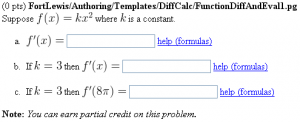Difference between revisions of "DifferentiateFunction1"
| Line 83: | Line 83: | ||
$answer[0] = $fx; |
$answer[0] = $fx; |
||
| − | $answer[1] = $fx->substitute(k=>$k); |
+ | $answer[1] = $fx->substitute(k=>$k); |
| − | $answer[2] = $fx->substitute(x=>$a*pi,k=>$k); |
+ | $answer[2] = $fx->substitute(x=>$a*pi,k=>$k); |
| − | #$answer[2] = $fx->eval(x=>$a*pi,k=>$k); # real |
||
</pre> |
</pre> |
||
</td> |
</td> |
||
| Line 97: | Line 97: | ||
* <code>eval()</code> returns a Real (a number) |
* <code>eval()</code> returns a Real (a number) |
||
* <code>substitute()</code> returns a Formula |
* <code>substitute()</code> returns a Formula |
||
| − | Since plugging a particular number <code>$k</code> into the Formula <code>$f</code> returns a Formula <code>$k x</code>, if we had used the eval method <code>$answer[1] = $fx->eval(k=>$k);</code> |
+ | Since plugging a particular number <code>$k</code> into the Formula <code>$f</code> returns a Formula <code>$k x</code>, if we had used the eval method <code>$answer[1] = $fx->eval(k=>$k);</code> instead of the substitute method, we would get errors because <code>$k x</code> is a Formula, not a Real. |
| + | </p> |
||
| + | <p> |
||
| + | When the answer is a constant, we can use either the eval method, in which case the answer would be a Real, or the substitute method, in which case the answer would be a constant Formula. If you use the eval method, <code>$answer[2] = $fx->eval(x=>$a*pi,k=>$k);</code> the answer will be a Real and will display as a single number in decimal format. If you use the substitute method instead, you have more control over how the answer will be displayed. In particular, the context flag |
||
| + | <code>reduceConstants=>0</code> controls whether the answer will be reduced to a single number in decimal format, the flag <code>reduceConstantFunctions=>1</code> controls whether or not expressions such as <code>4+5*2</code> are reduced to <code>14</code>, and setting the context flag <code>formatStudentAnswer=>'parsed'</code> will prevent the student's answer from being reduced to a single number in decimal format and will also display <code>pi</code> instead of <code>3.14159...</code> |
||
</p> |
</p> |
||
<p> |
<p> |
||
Revision as of 18:40, 4 December 2010
Differentiating and Evaluating a Function
This PG code shows how to create a function using MathObjects, differentiate it, and evaluate it.
- Download file: File:DifferentiateFunction1.txt (change the file extension from txt to pg when you save it)
- File location in NPL:
FortLewis/Authoring/Templates/DiffCalc/DifferentiateFunction1.pg
| PG problem file | Explanation |
|---|---|
|
Problem tagging: |
|
DOCUMENT(); loadMacros( "PGstandard.pl", "MathObjects.pl", "AnswerFormatHelp.pl", "unionLists.pl", ); TEXT(beginproblem()); |
Initialization:
We load |
Context("Numeric")->variables->add(k=>"Real");
Context()->flags->set(
reduceConstants=>0, # no decimals
reduceConstantFunctions=>1, # combine 4+5*2?
formatStudentAnswer=>'parsed', # no decimals
);
$a = random(6,9,1);
$k = random(3,5,1);
$f = Formula("k x^2");
$fx = $f->D('x');
@answer = ();
$answer[0] = $fx;
$answer[1] = $fx->substitute(k=>$k);
$answer[2] = $fx->substitute(x=>$a*pi,k=>$k);
|
Setup:
The partial differentiation operator is
The main difference between
$k into the Formula $f returns a Formula $k x, if we had used the eval method $answer[1] = $fx->eval(k=>$k); instead of the substitute method, we would get errors because $k x is a Formula, not a Real.
When the answer is a constant, we can use either the eval method, in which case the answer would be a Real, or the substitute method, in which case the answer would be a constant Formula. If you use the eval method,
Setting the context flag |
Context()->texStrings;
BEGIN_TEXT
Suppose \( f(x) = $f \) where \( k \) is a
constant.
\{ BeginList("OL",type=>"a") \}
$ITEM \( f'(x) = \)
\{ ans_rule(20) \}
\{ AnswerFormatHelp("formulas") \}
$ITEM If \( k = $k \) then \( f'(x) = \)
\{ ans_rule(20) \}
\{ AnswerFormatHelp("formulas") \}
$ITEM If \( k = $k \) then \( f'($a\pi) = \)
\{ ans_rule(20) \}
\{ AnswerFormatHelp("formulas") \}
\{ EndList("OL") \}
END_TEXT
Context()->normalStrings;
|
Main Text: |
$showPartialCorrectAnswers = 1;
foreach my $i (0..2) {
ANS( $answer[$i]->cmp() );
}
|
Answer Evaluation: |
Context()->texStrings;
BEGIN_SOLUTION
${PAR}SOLUTION:${PAR}
Solution explanation goes here.
END_SOLUTION
Context()->normalStrings;
COMMENT("MathObject version.");
ENDDOCUMENT();
|
Solution: |
